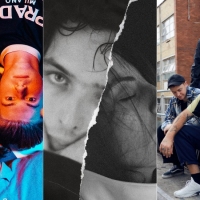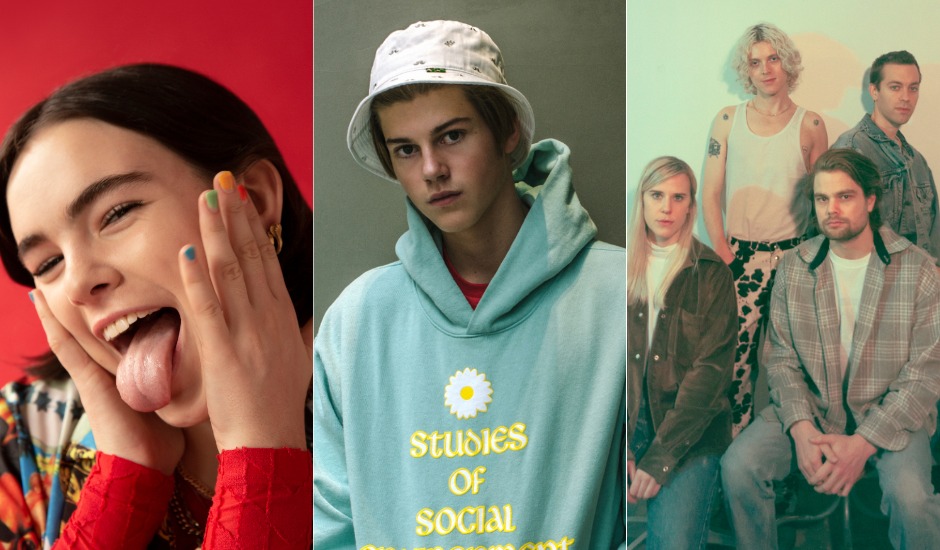 This week's must-listen singles: Willaris. K, Cosmo's Midnight, DMA's + moreAll that, plus new singles from Yorke and The Kite String Tangle.
This week's must-listen singles: Willaris. K, Cosmo's Midnight, DMA's + moreAll that, plus new singles from Yorke and The Kite String Tangle.

From stan accounts to TikTok, social media is creating our next popstars
In 2020, record labels no longer decide what blows up. Now, it’s the next generation who have control.
Once upon a time, success in the music industry had a very linear pathway. You’d often share demos with radio stations and show promoters in the hope of getting an odd plug, attract enough attention to start making a fanbase, use that fanbase to leverage management, booking and label deals, and then you’re away (for the most part). Nowadays, that pathway is still valid and common and you could name a handful of acts to hit #1 last year that have used this model to get there. However, at the same time, it’s no longer the only way to do it - and it hasn’t been in a long time.
Take a look at all the songs to reach #1 on the ARIA Charts, for example. Many of the number ones in the first half of the year - Ariana Grande, The Jonas Brothers - were through this highly calculated, label/management-controlled stream. In the second half of the year, only four songs reached the chart’s peak: Old Town Road, the runaway hit from Lil Nas X that began as a social media meme and ended up a constantly-remixed TikTok sensation; Señorita, the Shawn Mendes and Camila Cabello collaboration whose hyper-publicised relationship could only secure it one week; Tones And I’s Dance Monkey, triple j success story turned social media phenomenon that left the year with the nation’s longest-charting number one single ever; and Mariah’s All I Want For Christmas Is You, which as you’d expect, reached number one for the week that tracked the Christmas break.
While there is a chance that this may have been a one-off outlier never to be repeated, something tells me that it’s only the beginning. On the ARIA Charts today, there’s another track in the top ten that initially began its climb as a cult-followed flash of virality - Roddy Ricch’s The Box, which has been #1 in the US for a few weeks now - and beyond that, there are others looming, promising to break into the top ten at any moment: Arizona Zervas’s ROXANNE (which has already peaked at number two), Regard’s Ride It, Meduza’s Lose Control, Trevor Daniel’s Falling, BROCKHAMPTON’s Sugar and BENEE’s Glitter all began their rise through TikTok and other forms of social media success.
In 2020, it’s becoming clear that record labels have the smallest control over what becomes popular, often latching themselves onto musicians after the smallest suggestion of something big (Lil Nas X and Tones And I, for example, were both signed to divisions of Sony Music in 2019). Instead, it’s now the kids who have control, and even down here in Australia - a place so often detached from international virality - we’re feeling the ripple effects of otherwise naive musicians quickly becoming musical successes.
Take BENEE, for example. Technically from New Zealand (for the sake of making a point, we’re going to include her this time around), the rising musician found herself beginning a path to success with a string of singles that would eventually be compiled into her debut EP, last year’s FIRE ON MARZZ. At that point, songs like Soaked had given her moderate acclaim in Australia - it reached #58 in the Hottest 100 of that year - but it wouldn’t even hold a candle to what she’d face in the second half of the year, where singles like Glitter found themselves as an unsuspecting TikTok dance.
If you’re seeing BENEE at Laneway Festival or have tapped into the strange, confusing world that is TikTok, chances are you know all about the dance. If not, it’s a simple one that has become one of TikTok’s unexplainable phenomenons, the flow-on effect being a major increase in BENEE’s visibility not just in Australia and New Zealand, but globally. Now, BENEE’s Glitter has twice the streams as any of her other songs bar Soaked, is charting commercially in multiple countries, and gave her a new Hottest 100 peak at #18. Her sets at Laneway are amongst the festival’s busiest, despite early-afternoon, sun-stroked times.
In Australia, Tones And I has seen a similar feat in regards to TikTok virality, in a story that’s perhaps been told one too many times, but is definitely worth repeating. Her debut single Johnny Run Away was a big success for triple j’s independent music discovery platform Unearthed, eventually finding a glimpse of commercial success - a rare feat for a platform that has birthed the careers of many independent and alternative acts, from Flume to Courtney Barnett. However, Dance Monkey was the track that took Tones And I to international waters; the track being the Australia’s biggest success in the US and Europe for years and finding itself the longest-running #1 single back home.
Dance Monkey’s success is confusing, largely because it traces back to a variety of sources. It’s been a streaming success - it has over a billion streams on Spotify alone (!) and has found itself irremovable from Australia’s most streamed songs daily - and has been thrashed on the radio to point of people’s complaints of overexposure. Unconventionally, however, the track’s early popularity lies in social media memes and - you guessed it - TikTok, with its popularity there being the catalyst that led to more streams outside of social media apps, then radio plugs and what-not to keep to the continued demand of plays and adds.
While Tones And I may be the only obvious example of TikTok’s ability to blow up artists overnight reaching Australia, there’s something else going on in social media doing it instead: stan culture. Stan culture is a great - albeit often problematic - byproduct of social media’s intense fascination with celebrities and fame, largely the cause of Twitter arguments over who ‘flopped’ on the charts, random ‘fancam’ videos of K-Pop groups like BLACKPINK in Pitchfork comment streams, and the mass-spamming of bees, snakes and other emojis on popstars’ social media accounts when they backhandedly shoot a negative comment about another.
Stan culture isn’t anything new - it’s been an interesting character to Twitter for a few years now - but often it’s reserved for largely US-based musicians amongst music’s biggest: Taylor Swift, Beyoncé, Katy Perry and Ariana Grande having the most active (and simultaneously most vicious yet supporting) fanbases on the platform. Prior to last year, the only Australian musician with a particularly vocal stan culture surrounding them was Troye Sivan, and that’s always been the case - a premiere of his song crashed this website in seconds back in the mid-2010s.
In 2020, however, things are changing and stan culture is beginning to blossom in the comments of Australian artists’ photos too. Ruel is an unavoidable example. The Sydney wunderkind has had a burgeoning, cult-like fanbase since his earliest debuts with M-Phazes, but now - three years later, in 2020 - his fanbase have become a swarm of love and support that extend even beyond just his socials: his photographer, Michelle Grace Hunder, often receives hundreds of comments and thousands of likes whenever she posts galleries of Ruel taken on the road, and literally any piece of media that captures the fanbase’s attention will be inundated with traction - a remarkably incredible thing that brings a long-lost sense of passion back to the music industry.
Then, there are the results it’s having on Ruel’s career too. Ruel is entering 2020 one of Australia’s brightest stars, blossoming both at home - his second EP Free Time peaked in the top three of the ARIA Charts, and his shows often sell out in an instant - and internationally, where he’s been hand-picked by Tyler, The Creator to play his Camp Flog Gnaw festival and debuted at Coachella as a surprise guest during SG Lewis’ set. In 2020, who knows where that success will go? All we can say is that when he finally delivers his debut album, it’s going to take one hell of an upset to stop him from debuting at number one with it.
Elsewhere, musicians who have been focal in Australian pop for much longer than Ruel are currently experiencing their biggest career peaks to date as a result of stan culture. Cub Sport, for instance, have been adored in Australian indie since their ex-name caught legal attention from Australian Cub Scouts, but are currently more popular than they’ve ever been: their self-titled latest album being their greatest success on the ARIA Charts, for example, and their headline tour a sell-out. Once, Cub Sport’s success came from festival shows and triple j rotation. Nowadays, it comes thanks to the legion of fans - some of the most supportive and lovely people in the world - who get behind their every move, including stan accounts especially for them that you’d only often find in music’s biggest stars (Cub Sport are still self-managed and independent to this day).
A good friend of Cub Sport and another to experience this stan-esque sensation is Mallrat. Again, the Brisbane-raised musician has been a long-time favourite in Australian music since the mid-2010s triple j explosion, but her latest work - last year’s Driving Music - was her most heavily supported to date; her ARIA Album Chart debut (#10), ARIA Single Chart peak (#50 for Charlie) and unexpected Hottest 100 peak (#3, also for Charlie) the result of endless promotion and support from a fanbase that swells every second. Much like Ruel and Cub Sport, Mallrat’s fanbase is one that escapes the notorious viciousness of stan culture that surrounds US popstars - they’re 100% wholesome, and 100% supportive of every mood.
The point is, in 2020, who knows where our next star can come from. Today, they are glimpses of virality or stan-backed cult-favourites just as often as they are major label darlings with every single release and social media comment meticulously calculated and planned out. Who knows what they’ll be tomorrow.
 This week's must-listen singles: Willaris. K, Cosmo's Midnight, DMA's + moreAll that, plus new singles from Yorke and The Kite String Tangle.
This week's must-listen singles: Willaris. K, Cosmo's Midnight, DMA's + moreAll that, plus new singles from Yorke and The Kite String Tangle.
 A guide to Wide Open Space Festival’s getaway comp, and the ways you can use itWinning a getaway for two in Central Australia can set you up with a holiday for a lifetime, let alone one with a Sampa The Great-headlined festival.
A guide to Wide Open Space Festival’s getaway comp, and the ways you can use itWinning a getaway for two in Central Australia can set you up with a holiday for a lifetime, let alone one with a Sampa The Great-headlined festival.